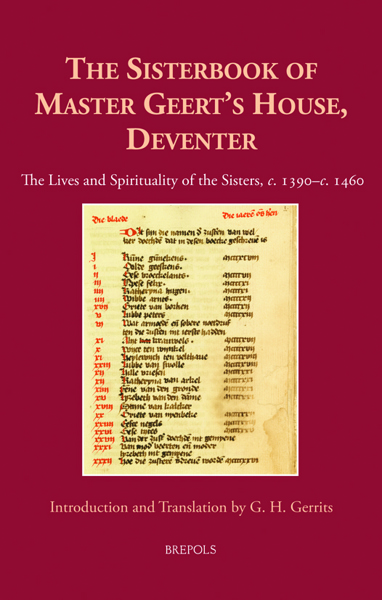
The Sisterbook of Master Geert’s House, Deventer
The Lives and Spirituality of the Sisters, c. 1390–c. 1460
G. H. Gerrits
- Pages: 352 p.
- Size:156 x 234 mm
- Illustrations:1 b/w, 3 col.
- Language(s):English
- Publication Year:2024
- € 105,00 EXCL. VAT RETAIL PRICE
- ISBN: 978-2-503-60249-3
- Hardback
- Available
- € 105,00 EXCL. VAT RETAIL PRICE
- ISBN: 978-2-503-60250-9
- E-book
- Available
A study and translation of the Sisterbook of Master Geert’s House, from a late medieval community of religious women in Deventer.
The book shows the significance of this work in the Devotio Moderna and late medieval female religiosity, while the accompanying translation introduces this important source to an English audience.
"This book is a gift, enabling readers to penetrate the world of religious women in Western Europe at the end of the Middle Ages.(...) We should be grateful to the anonymous compiler of the Sisterbook and to G. H. Gerrits for bringing the sisters of Deventer to our attention." (Thomas A. Fudge, in Parergon, 42/2, 2025, p. 226-228)
G. H. Gerrits: The author-translator’s leading contributions to the study of the Modern Devotion are studies of the thought of Gerard Zerbolt of Zutphen (1367–1398) and Johan Brinckerinck (1359–1419). A second field of research and publication is the Dutch-Canadian community in the Maritime provinces of Canada. He taught Medieval, Renaissance and Reformation history at Acadia University, Wolfville, Nova Scotia, for nearly thirty years.
The Sisterbook of Master Geert’s House contains the lives of sixty-four Sisters of the Common Life who died between 1398 and 1456. Founded as an alms-house for destitute women in 1374, by the end of the fourteenth century Master Geert’s House had become a home for women desiring to live a life of humility and penitence, as well as in community of goods without vows. The Sisterbook was likely written sometime between 1460 and 1470, at a time when the religious fervour that had characterized the earlier Sisters had begun to wane. It was to incite the readers and hearers of the Sisterbook, which would have been read in the refectory during mealtimes, to imitate the earlier Sisters who are portrayed as outstanding examples of godliness and Sisters of the Common Life. The opening sentence of the Sisterbook succinctly sums up the author’s reason for writing it: ‘Here begin some edifying points about our earlier Sisters whose lives it behoves us to have before our eyes at all times, for in their ways they were truly like a candle on a candlestick’, and who, by implication, could still illumine the way for her own generation of Sisters. The first foundation of Sisters of the Common Life, Master Geert’s House became the ‘mother’ house of numerous other houses in the Low Countries and Germany directly as well as indirectly and served as an inspiration for others.
This book provides a study of the Sisterbook and its significance in the Devotio Moderna and late medieval female religiosity, while the accompanying translation introduces this important source to an English audience.
Introduction
The Sisterbook of Master Geert’s House, One of a ‘Family’ of Five
The Sister Community in Master Geert’s House and Its Daily Routine
The History of the House of Master Geert
The Sisters. A Prosopographical Overview
The Mistress, and Other Offices
The Founding of New Sister Houses and the Reformation of Others
Profectus virtutum (Progress in the Virtues), the Guiding Principle in the Sisters’ Lives and Spirituality
The Sisterbook of Master Geert’s House: Its Composition and Sources
The Sisterbook: Genre and Resemblance to Other Sisterbooks
The Bible and Christian Authors Cited in the Sisterbook
Dirk de Man’s Edition of the Sisterbook and the Present Translation
The Sisterbook of Master Geert’s House, Deventer. The Lives and Spirituality of the Sisters
Appendix 1. List of Mothers/Mistresses and Priest‑Rectors of Master Geert’s House
Appendix 2. Sisters Mentioned in the Sisterbook that Do Not Have their Own Vita
Bibliography
Index of Biblical Texts
Index of Names and Places
Subject Index




